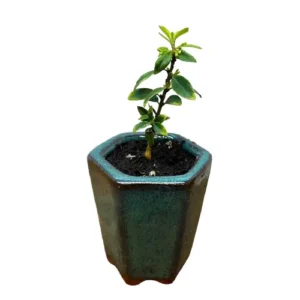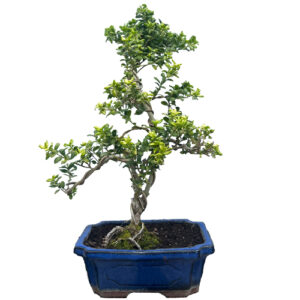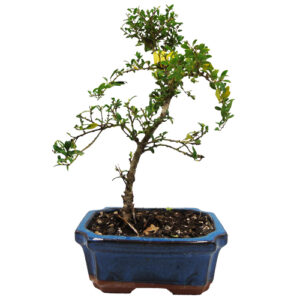Japanese Holly Bonsai Tree (ilex crenata) is an evergreen species that is best kept outdoors. Japanese Holly produces white flowers and small black berries
Japanese Holly bonsai tree (ilex crenata)
Placement
Japanese Holly bonsai trees can be grown both indoors and outdoors, depending on where you live and your preference. Native to East China, Japan, Korea and Taiwan, the Japanese Holly prefers a temperate climate and can tolerate most conditions but avoid harsh sun or heat in warmer months, and frost in the winter. If placing outside, choose a location that receives ample sunlight throughout the day, but provide semi-shade during the midday when the sun is at its strongest to prevent leaf burn. In the winter months, protect your tree from frost and strong winds, and consider using a cold frame or bringing it indoors to an unheated space such as a garage or shed to allow for its dormancy period. Cooler temperatures that do not fall below 5 °C are ideal for this.
If placing indoors, choose a windowsill that gets plenty of sunlight. Japanese holly bonsai trees can tolerate low light conditions, but this may result in slower growth and discolouration of the leaves. If you need to place your bonsai tree in a location with lower light levels, consider supplementing with artificial grow lights to provide adequate energy for healthy growth. Keep in mind that Japanese holly bonsai trees are sensitive to temperature changes so it is best to avoid placing your tree in areas with cold draughts or exposure to artificial heat sources such as radiators.
Watering
There is no definitive guide to watering and it should be conducted on an observational schedule, not a routine. This means that it is important to keep an eye on the moisture levels of the soil to avoid over and under watering, both of which can lead to dropping leaves and/or root death. The amount of water a bonsai requires depends on pot size, climate, airflow, soil and tree type so it is best to use your eyes and fingers to assess whether the soil is damp, wet or dry. As a general guide, if the top inch or so has dried, it is ready to be watered. When you water, ensure an even coverage over the roots and soil, allowing water to flow out from the bottom of the pot to allow for a good soaking. Never let the soil dry out completely and never let your bonsai sit in water for long periods of time.
The Japanese holly bonsai tree also benefits from slightly higher humidity levels. This can be achieved by using a mister to spray the leaves, as well as placing a gravel tray under the pot to create a more humid microclimate around the tree.
Feeding and fertilizing
Using fertiliser on your Japanese holly bonsai tree will help encourage healthy growth and this should be done periodically from once a week to every two months and only during the growing season. You can start adding nutrients to your water from March until October and use weekly. If using solid fertilizer, use once every one to two months. With bonsai trees, less is more and we tend to advise using half the recommended dosage to see how your bonsai reacts first.
Pruning and wiring
Pruning your bonsai is important not only to maintain or create an aesthetic style but to also ensure light and airflow can reach inner leaves and the Japanese holly tolerates constant pruning very well. During the early to late spring months use appropriate tools to cut back stems which have grown longer than four leaves, leaving the two leaves which are closest to the stem intact. You can repeat this process when new stems appear after pruning. If you are looking to encourage flowers and fruits, stop pruning your Japanese holly bonsai tree in early summer.
Training your bonsai using wiring is best done during the later spring and summer months growing period when the stems and branches are easier to bend. Wiring a Japanese holly bonsai tree can be slightly challenging as the branches are brittle and the bark can be damaged, so take care not to wrap wire too tightly and risk loss of circulation or scarring.
Repotting
Repotting your tree is an important way to provide a fresh and suitable soil mix and ensure appropriate root health. As a general rule, your Japanese holly bonsai tree will need to be re-potted every other year, and only in spring, but you should check if it has become root-bound before you change pots. You can do this by lifting the tree gently out of the pot by the main trunk and examining the root system. You will know it is ready if you can see the roots are circling around each other and the pot. If, however they still appear contained in the soil, you should place it back and wait until the following spring to check again.
Showing all 4 results




